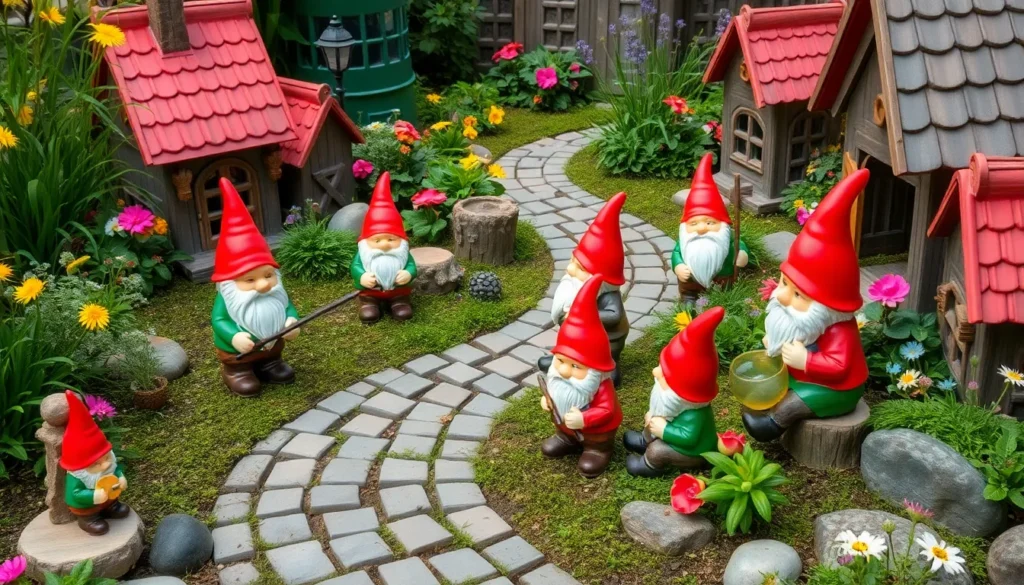We’ve all walked past those charming garden displays featuring tiny gnomes tucked between flowers and wondered how to create our own magical outdoor space. Gnome gardens transform ordinary yards into whimsical wonderlands that spark joy and conversation with every visitor who stops by.
Whether you’re working with a sprawling backyard or a cozy balcony container garden, we’ll show you how to design an enchanting gnome village that reflects your personality. From selecting the perfect miniature residents to creating tiny pathways and fairy-tale accessories, the possibilities are endless when you let your imagination run wild.
Creating a gnome garden isn’t just about placing figurines randomly around your plants – it’s about crafting a cohesive story that brings your outdoor space to life. We’ll explore creative themes, essential elements, and practical tips that’ll help you build a garden that’s Instagram-worthy and conversation-starting.
Classic Fairy Tale Gnome Village Setup
We’ll transform your garden into an enchanting fairy tale industry where traditional gnomes become the stars of their own magical neighborhood.
Traditional Red-Capped Garden Gnomes
Traditional red-capped gnomes serve as the foundation characters for our fairy tale village setup. We recommend selecting gnomes with distinct personalities like fishermen, gardeners, or musicians to create captivating storylines throughout your space. Classic gnomes typically stand 8-12 inches tall and feature the iconic pointed red hats, white beards, and colorful tunics that make them instantly recognizable.
Position your red-capped residents in small clusters of 2-3 gnomes to create natural conversation groups. We’ve found that placing a gnome reading a book near a miniature bench while another tends to tiny vegetables creates compelling visual narratives. Choose gnomes with weatherproof resin or ceramic construction to ensure they’ll withstand outdoor conditions while maintaining their vibrant colors.
Miniature Cottage and House Arrangements
Miniature cottages provide essential housing for our gnome community and anchor the village’s overall design. We suggest arranging 3-5 small houses in a semicircle or along a curved line to create a natural village layout. Fairy houses with thatched roofs, tiny windows, and working doors add authentic charm to the setup.
Place larger cottages toward the back of your display area and smaller ones in front to create visual depth. We recommend choosing houses with different architectural styles like Tudor cottages, mushroom houses, or tree stump dwellings to add variety. Battery-operated LED lights inside the cottages create magical evening ambiance that transforms your garden into a glowing fairy tale scene.
Winding Cobblestone Pathways
Winding cobblestone pathways connect your gnome village elements and guide visitors through the magical industry. We use small decorative stones, mini pebbles, or specialized fairy garden pathway kits to create realistic looking roads. Curved pathways feel more natural and whimsical than straight lines in fairy tale settings.
Create your main pathway using stones that are roughly 1/4 to 1/2 inch in diameter for proper scale with standard gnome figures. We recommend laying the pathway first, then positioning houses and gnomes along its route to ensure everything connects logically. Add tiny stepping stones that branch off the main path to create secondary routes leading to individual cottages or special garden features like miniature bridges or wells.
Themed Gnome Garden Collections

Building on your foundational gnome village, we’ll explore specialized collections that bring unique storytelling elements to your garden design. These themed approaches allow you to create multiple distinct areas within your space while maintaining visual coherence.
Seasonal Holiday Gnome Displays
Oktoberfest themed displays bring festive German culture directly into your garden space. We recommend positioning lederhosen wearing gnomes around miniature beer barrels and Bavarian style decorations to create an authentic celebration atmosphere. Small pretzels, German flags, and tiny accordion accessories enhance the cultural immersion experience.
Fall themed arrangements capture autumn’s natural beauty through strategic color coordination and seasonal elements. Orange and burgundy capped gnomes work alongside harvest accessories like miniature pumpkins, corn stalks, and leaf garlands. We suggest clustering these displays near existing autumn flowering plants to amplify the seasonal impact.
Winter wonderland scenes transform your garden into a magical snowy industry year round. White and blue toned gnomes positioned among artificial snow, icicle decorations, and miniature evergreen trees create compelling winter narratives. Frosted glass accessories and silver metallic elements add sparkle to these enchanting displays.
Occupation-Based Gnome Scenarios
Gardening focused gnomes establish natural connections between your miniature residents and their plant surroundings. We position these industrious characters with tiny watering cans, seed packets, and miniature garden tools among your actual flower beds. Wheelbarrows, plant stakes, and small greenhouse structures complete these authentic working scenes.
Crafting workshops showcase gnomes engaged in traditional artisan activities throughout your garden space. Woodworking gnomes with miniature sawhorses and tool benches create ever-changing work environments. Pottery themed displays feature gnomes at tiny wheels with clay pots and ceramic accessories scattered nearby.
Culinary scenes bring kitchen magic into outdoor settings through food preparation narratives. Chef hat wearing gnomes positioned around miniature outdoor kitchens, bread ovens, and dining sets create captivating mealtime stories. We include tiny food accessories like fruits, vegetables, and cooking utensils to enhance these delicious displays.
Fantasy Adventure Gnome Stories
Search themed adventures transform your garden into an epic journey industry filled with exploration elements. Map carrying gnomes equipped with compasses, hiking gear, and treasure chests create compelling adventure narratives. We scatter directional signs, milestone markers, and discovery artifacts along designated pathways to guide the storyline.
Mythical creature interactions bring legendary beings into your gnome community through strategic character placement. Dragon befriending gnomes, unicorn caretakers, and mermaid companions create magical relationship dynamics. Fantastical accessories like crystal formations, magical portals, and enchanted springs support these extraordinary friendships.
Magical forest environments establish gnomes as nature’s guardians within your garden network. Spell casting gnomes with wands, potion bottles, and mystical symbols create supernatural atmosphere. We incorporate glowing accessories, fairy lights, and color changing elements to emphasize the magical properties of these woodland protectors.
DIY Gnome Habitat Construction Ideas
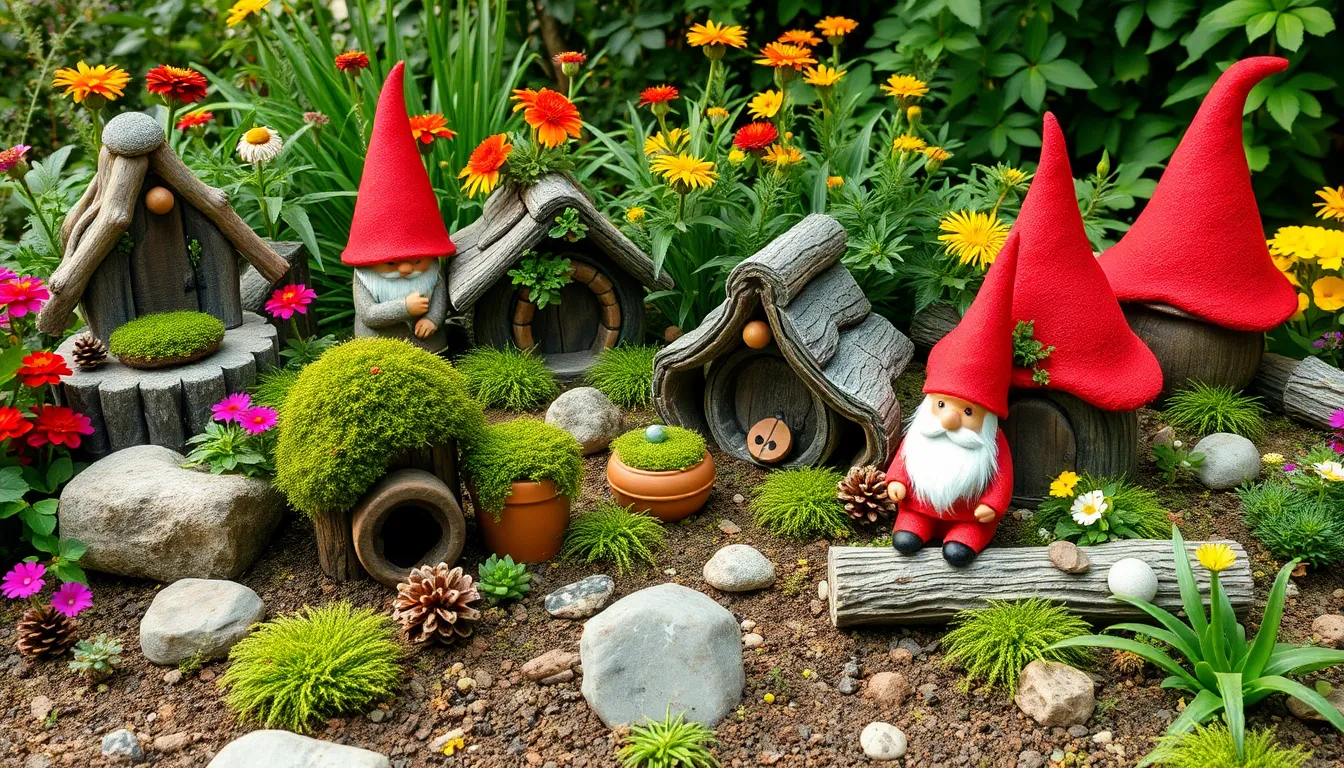
Building custom gnome habitats lets us create authentic homes that perfectly match our garden’s unique story and personality.
Natural Rock and Stone Formations
Rock piles become the foundation for authentic gnome dwellings when we stack varying sizes of stones to create natural looking caves and shelters. Small pebbles work perfectly for creating realistic doorways and windows in these rocky formations. Stone pathways guide visitors through our gnome village while connecting different habitat areas with natural elegance. Flat slate pieces serve as roofing materials for our rock based gnome homes, providing weather protection while maintaining an organic appearance. River rocks add texture and visual interest when we arrange them around the base of each stone dwelling.
Repurposed Container Gnome Homes
Terra cotta pots transform into charming tree trunk homes when we paint them brown and add bark like texture with acrylic paints. Clay planters serve as excellent bases for multi level gnome houses, allowing us to stack different sized containers for architectural variety. Plastic containers work wonderfully for weather resistant gnome homes, especially when we drill drainage holes and add decorative elements like moss or small plants. Old teacups and saucers create whimsical fairy sized dwellings that complement our gnome neighborhoods. Mason jars become transparent gnome observation domes when we turn them upside down over miniature scenes.
Wooden Log and Branch Structures
Small wooden logs provide sturdy foundations for rustic gnome cabins when we hollow out sections to create doorways and windows. Twigs and branches serve as building materials for furniture pieces like benches, chairs, and tiny tables inside our gnome homes. Bark pieces work as natural roofing shingles, giving our wooden structures an authentic forest dwelling appearance. Fallen branches become architectural elements when we arrange them as support beams and decorative trim around doorframes. Pine cones add textural details to our wooden gnome houses, serving as chimneys or decorative roof ornaments that blend seamlessly with natural surroundings.
Creative Gnome Garden Layout Designs
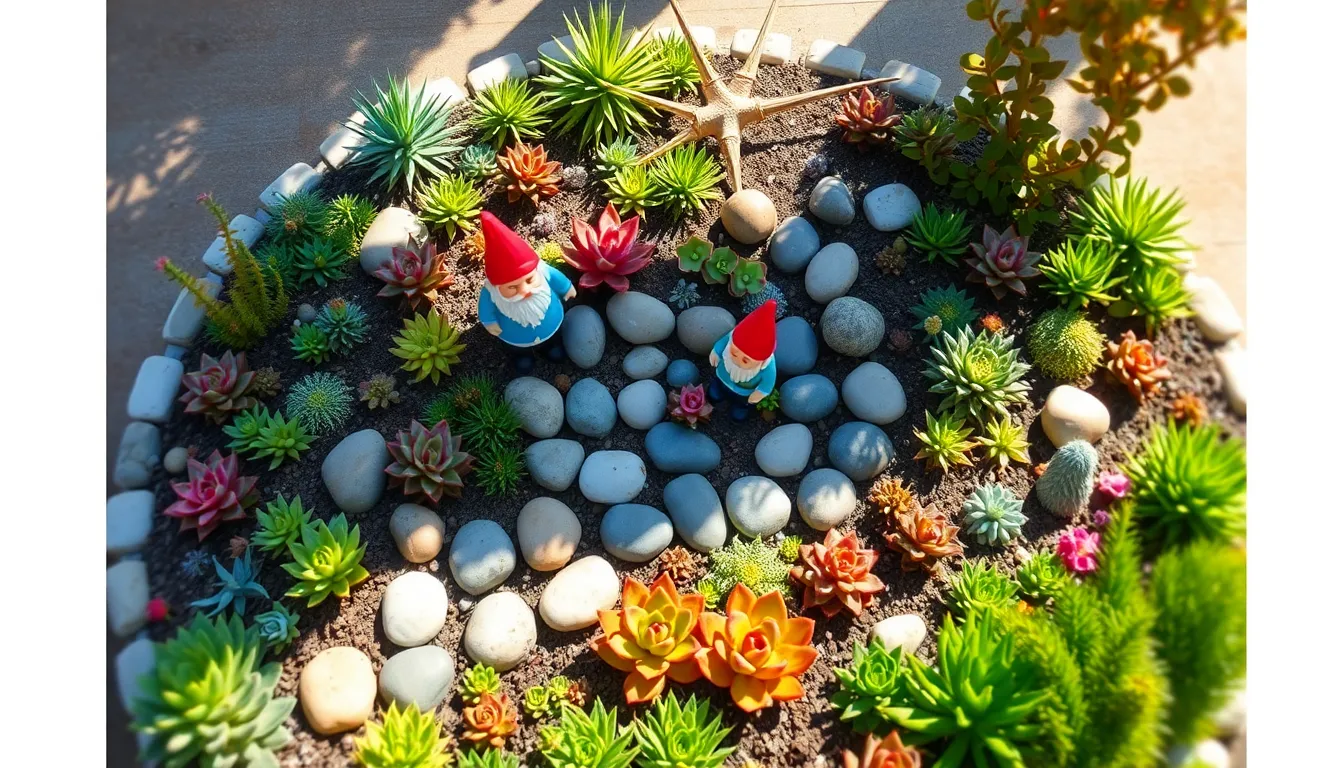
Now that we’ve established our gnome village foundation, let’s explore innovative layout patterns that’ll transform your garden into a mesmerizing miniature industry.
Spiral Garden Gnome Arrangements
Spiral arrangements create ever-changing visual journeys that draw visitors deeper into our gnome industry. We position plants or decorative stones in a spiral pattern, establishing a natural pathway that guides the eye through our miniature industry. Gnomes work perfectly when placed at the center of the spiral or strategically positioned along the curved path, suggesting they’re on a magical search or guarding hidden treasures.
Building these spiral gardens becomes incredibly simple using bricks, stones, or raised garden beds to define the curved boundaries. Succulents and low-growing perennials like creeping thyme fit beautifully into this layout, requiring minimal maintenance while providing year-round structure. We’ve found that placing a central gnome figure creates an anchor point, while smaller gnomes along the spiral suggest movement and adventure through the garden.
Tiered Level Gnome Landscapes
Tiered designs maximize our garden’s vertical space while creating the illusion of gnome villages nestled on rolling hillsides. We construct multiple levels using stacked planters, wooden boxes, or strategically placed stones to establish different elevation zones. Each tier hosts distinct plant species, miniature decorations, and carefully positioned gnome figures that appear to inhabit their own neighborhood level.
This layered approach works exceptionally well in small spaces where horizontal room is limited. Upper tiers showcase trailing plants like ivy or cascading succulents, while lower levels accommodate broader plantings and larger gnome accessories. We position gnomes to appear as though they’re climbing between levels, socializing across tiers, or tending gardens at different elevations, creating depth and storytelling opportunities throughout the vertical industry.
Corner Nook Gnome Sanctuaries
Corner nook sanctuaries transform forgotten garden spaces into enchanting gnome retreats that maximize every available inch. We use shade-tolerant plants, ground covers, and decorative rocks to create cozy habitats in areas that might otherwise remain unused. These intimate spaces work particularly well under trees, against fences, or in naturally sheltered garden corners where gnomes can appear to be resting or gathering.
Hostas, ferns, and moss create lush backgrounds in these shaded sanctuaries, while carefully arranged stones provide seating areas for our gnome residents. We position gnomes to look like they’re engaged in quiet activities such as reading, fishing in tiny ponds, or simply enjoying peaceful conversations. Corner sanctuaries offer the perfect opportunity to create intimate vignettes that reward visitors who take time to explore every corner of our gnome garden.
Miniature Accessories and Props
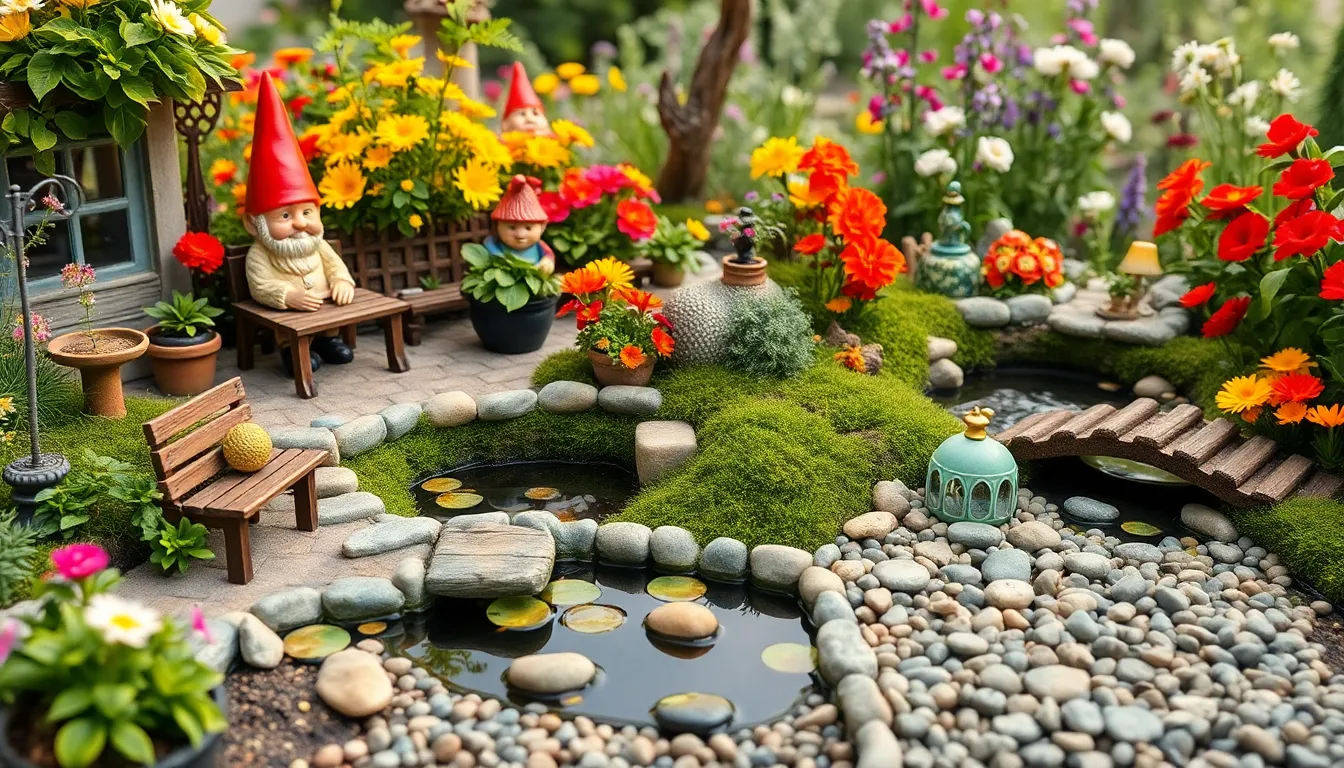
Accessorizing your gnome garden with carefully chosen miniature props transforms ordinary garden spaces into enchanted worlds. These tiny additions create depth and authenticity that makes every corner of your gnome village feel lived in and magical.
Tiny Garden Furniture and Tools
Garden furniture becomes the heart of any thriving gnome community when scaled to their diminutive size. Mini benches crafted from weather resistant materials provide perfect resting spots for your gnome figures while doubling as focal points along pathways. Position these small seating areas near flower beds or under miniature trees to create natural gathering spaces.
Essential garden tools add realistic touches that suggest your gnomes actively tend their surroundings. Miniature shovels, rakes, and watering cans scattered thoughtfully throughout plant beds tell stories of daily garden maintenance. We recommend clustering these tiny implements near gnome figures to create believable work scenes.
Tiny tables paired with matching chairs establish outdoor dining areas where gnome families might share meals. These furniture sets work exceptionally well when positioned on flat stones or wooden platforms to create stable surfaces. Consider adding miniature plates, cups, or food accessories to complete the dining experience.
Miniature Water Features and Ponds
Water elements bring life and movement to gnome gardens while creating peaceful focal points for contemplation. Small ponds constructed using birdbaths or shallow dishes provide reflection surfaces that double garden visual interest. These miniature water bodies support tiny floating plants like water lettuce or miniature water lilies.
Mini fountains powered by small pumps create gentle bubbling sounds that enhance the magical atmosphere. Solar powered fountain pumps offer eco friendly operation while eliminating the need for electrical connections. Position these features centrally to maximize their visual and auditory impact across your entire gnome garden.
Tiny waterfalls and streams add ever-changing movement using simple gravity fed systems. Create these features by positioning water containers at different heights and connecting them with flexible tubing hidden beneath decorative stones. The gentle trickling sound draws visitors deeper into your gnome industry while providing drinking spots for beneficial garden wildlife.
Small-Scale Bridges and Walkways
Bridges serve as both functional connectors and decorative statements that guide visitors through your gnome garden narrative. Mini bridges constructed from twigs, small stones, or weathered wood span miniature streams or simply create architectural interest over dry creek beds. These structures work best when they appear naturally integrated rather than obviously placed.
Stone paths wind through gnome territories using small pebbles, glass gems, or decorative gravel to create defined walkways. Varying the materials and colors along different path sections helps distinguish between garden areas while maintaining visual coherence. We suggest using lighter colored stones in shaded areas to improve visibility.
Wooden walkways built from small planks or bamboo stakes create elevated passages that protect delicate plantings below. These raised paths work particularly well in areas with moss or ground covers that shouldn’t be disturbed. Stain or seal wooden elements to ensure they withstand outdoor weather conditions throughout multiple seasons.
Plant Pairings for Gnome Gardens
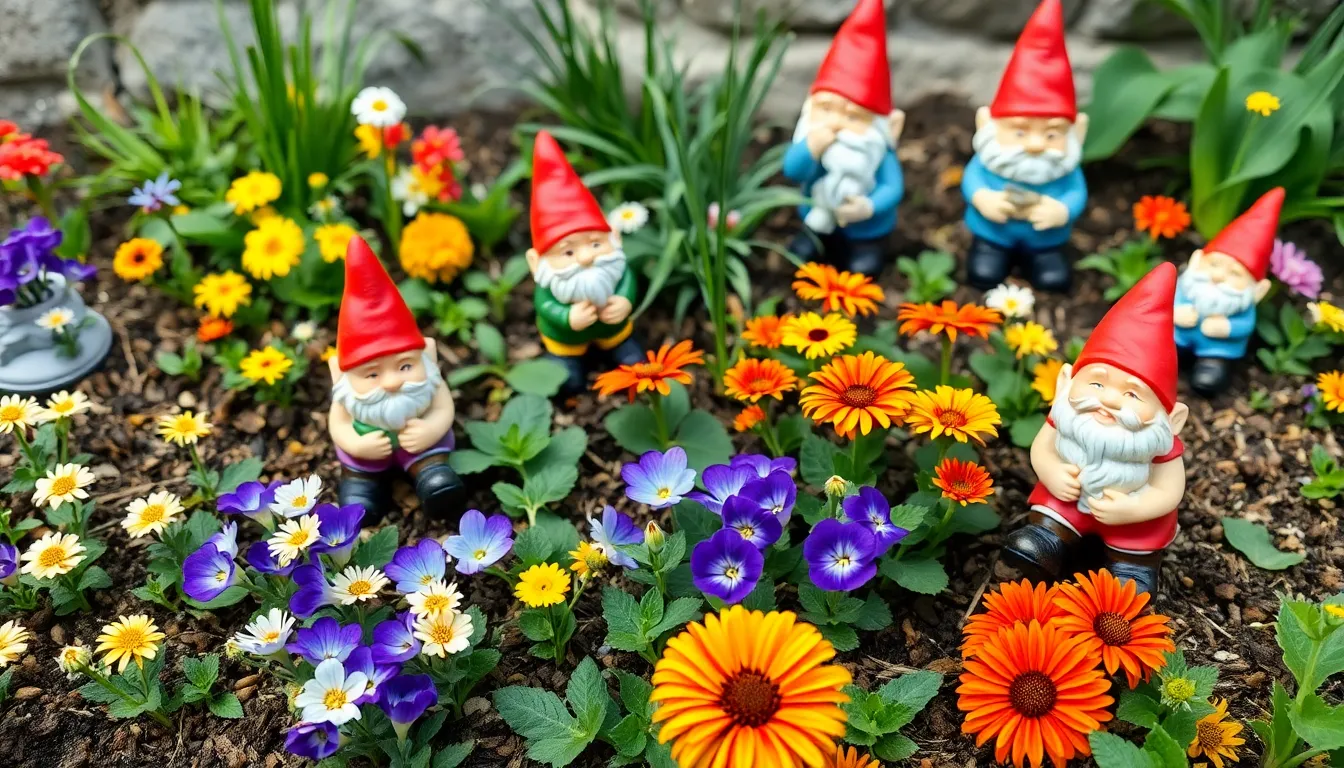
Selecting the right plants transforms your gnome garden from a simple collection of figurines into a living, breathing fantasy industry. We’ll explore exact plant combinations that complement miniature residents while maintaining proper scale and visual harmony.
Low-Growing Ground Cover Options
Creeping Jenny spreads quickly across garden beds and adds bright chartreuse foliage that creates a natural carpet around gnome homes. This vigorous perennial fills gaps between decorative stones and pathways while requiring minimal maintenance once established.
Dwarf Mondo Grass provides texture with its grass-like appearance and stays compact at just 2-4 inches tall. We recommend this evergreen option for year-round structure that won’t overwhelm tiny gnome accessories or block viewing angles of your miniature scenes.
Sweet Woodruff offers delicate white blooms in spring and thrives in shaded areas where many gnome sanctuaries are positioned. This low-maintenance ground cover grows 6-8 inches high and creates a soft backdrop for woodland themed gnome villages.
Creeping Thyme releases a pleasant fragrance when stepped on and produces tiny purple or white flowers throughout summer. This herb serves double duty as both ground cover and aromatic enhancement to your gnome garden experience.
Colorful Flower Companions
Violas produce small, delicate flowers in purple, yellow, and white that maintain perfect scale with gnome figurines. These cool-season annuals bloom from fall through spring in most climates and add cheerful color without overwhelming the miniature industry.
Pansies bring bright faces in colors ranging from deep purple to sunny yellow, creating whimsical expressions that mirror gnome personalities. We suggest planting them in clusters of 3-5 around gnome gathering areas to establish natural conversation circles.
Dwarf Marigolds grow only 6-8 inches tall and provide vibrant orange and yellow blooms throughout summer months. These compact annuals work especially well near gnome workshop areas and kitchen scenes where their warm colors suggest autumn harvest themes.
Alyssum creates clouds of tiny white, pink, or purple flowers that cascade over pathway edges and container gardens. This annual blooms continuously in cool weather and adds a cottage garden feel to traditional gnome village setups.
Herb Garden Gnome Integration
Miniature Rosemary varieties like ‘Blue Boy’ stay under 12 inches tall while providing fragrant needle-like foliage and small blue flowers. We position these evergreen herbs near gnome cooking scenes where their culinary associations enhance the storytelling elements.
Dwarf Basil cultivars such as ‘Spicy Globe’ form compact mounds perfect for gnome garden scale while offering fresh scents and edible leaves. These tender annuals thrive in warm weather and create realistic herb garden scenarios around chef gnomes.
Chives produce grass-like foliage topped with purple pom-pom flowers that gnomes can appear to harvest for their tiny kitchens. This perennial herb returns each year and tolerates frequent cutting, making it ideal for interactive garden displays.
Oregano spreads naturally to form aromatic mats that gnomes can walk through, while its small leaves and delicate flowers maintain appropriate proportions. We recommend Greek oregano varieties for their compact growth habit and intense fragrance that enhances Mediterranean gnome themes.
Budget-Friendly Gnome Garden Solutions
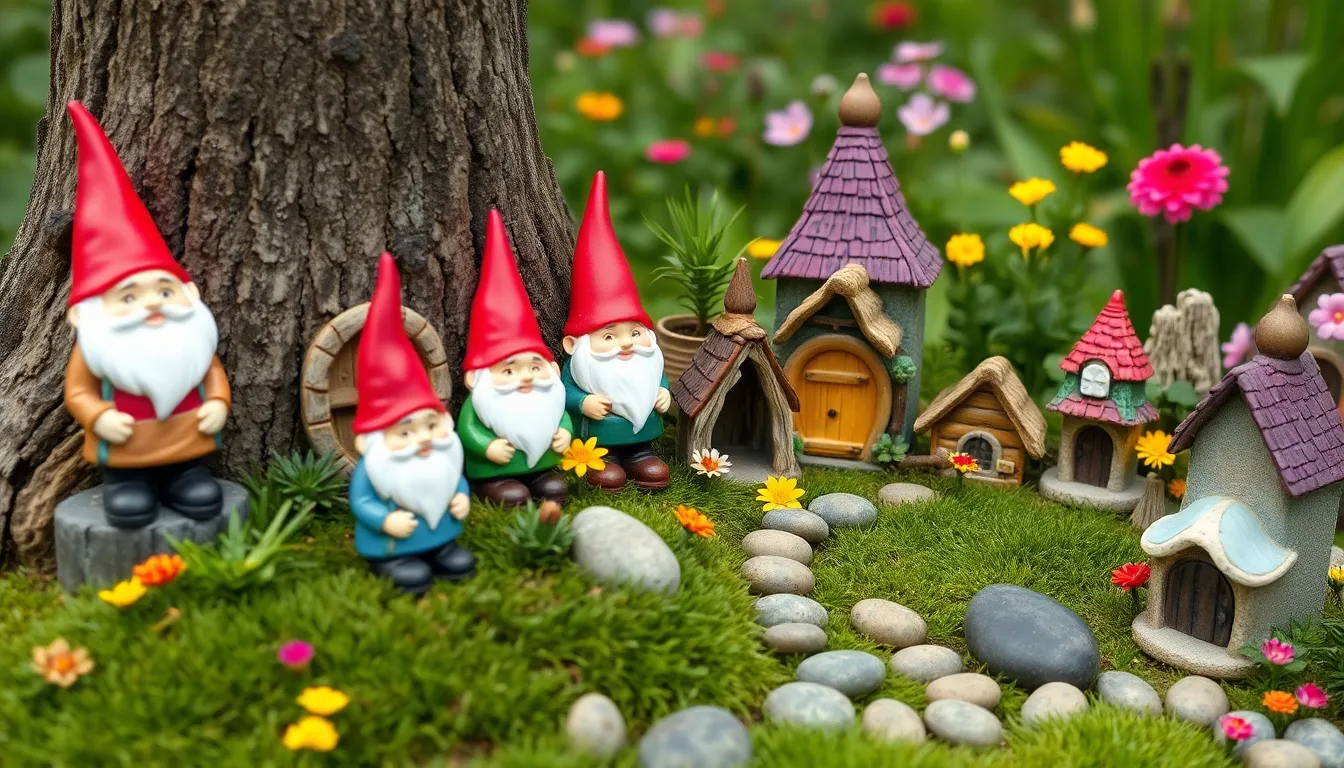
Creating a magical gnome garden doesn’t require a hefty investment. We’ve discovered many affordable alternatives that deliver the same whimsical charm as expensive garden center options.
Dollar Store Gnome Decorations
Dollar Tree’s Fairy Garden Cottages offer exceptional value for budget-conscious gardeners. These gnome-themed houses feature thatched or mossy roofs that perfectly complement our miniature village designs. We recommend purchasing multiple cottages to create diverse architectural styles throughout your gnome community.
Resin figurines provide an affordable way to populate your garden with gnomes, fairies, and magical creatures. These durable decorations withstand outdoor conditions while maintaining their vibrant colors season after season. Stock up on various characters to develop captivating storylines within your garden narrative.
Mini Fairy Doors add instant whimsy to any gnome setup. Available in seven distinct designs, these charming accessories create entry points for imaginary adventures. Position them at the base of trees or against garden walls to suggest hidden gnome pathways and secret meeting places.
Homemade Gnome Crafting Projects
Natural materials transform into enchanting gnome villages with minimal investment. Twigs and leaves collected from your yard create authentic homes that blend seamlessly with existing landscaping. We suggest building these structures during different seasons to incorporate varied textures and colors.
Recycled containers become charming gnome dwellings with creative repurposing. Old shoes, tin cans, and plastic containers offer unique architectural possibilities for your miniature community. Paint these items in earthy tones to maintain the magical forest aesthetic.
Stone painting projects create custom gnome pathways and decorative elements. Small river rocks painted with directional arrows, flowers, or tiny doors guide visitors through your garden while adding personalized touches. This create activity engages family members in the garden creation process.
Yard Sale and Thrift Store Finds
Local yard sales yield surprising treasures for gnome garden enthusiasts. Small planters, decorative stones, and ceramic figurines often sell for pennies compared to retail prices. We’ve discovered that early morning shopping provides the best selection before other gardeners arrive.
Repurposed household items create authentic gnome habitats with character. Old boots serve as cozy gnome homes, while wooden crates become elevated platforms for displaying your miniature residents. Small fabric scraps transform into curtains, blankets, and clothing for your gnome figures.
Thrift stores offer consistent inventory of garden-appropriate items throughout the year. Look for miniature furniture, small ceramic dishes, and decorative lanterns that enhance your gnome village atmosphere. These establishments often stock seasonal items at deeply discounted prices during off-peak months.
Seasonal Gnome Garden Maintenance
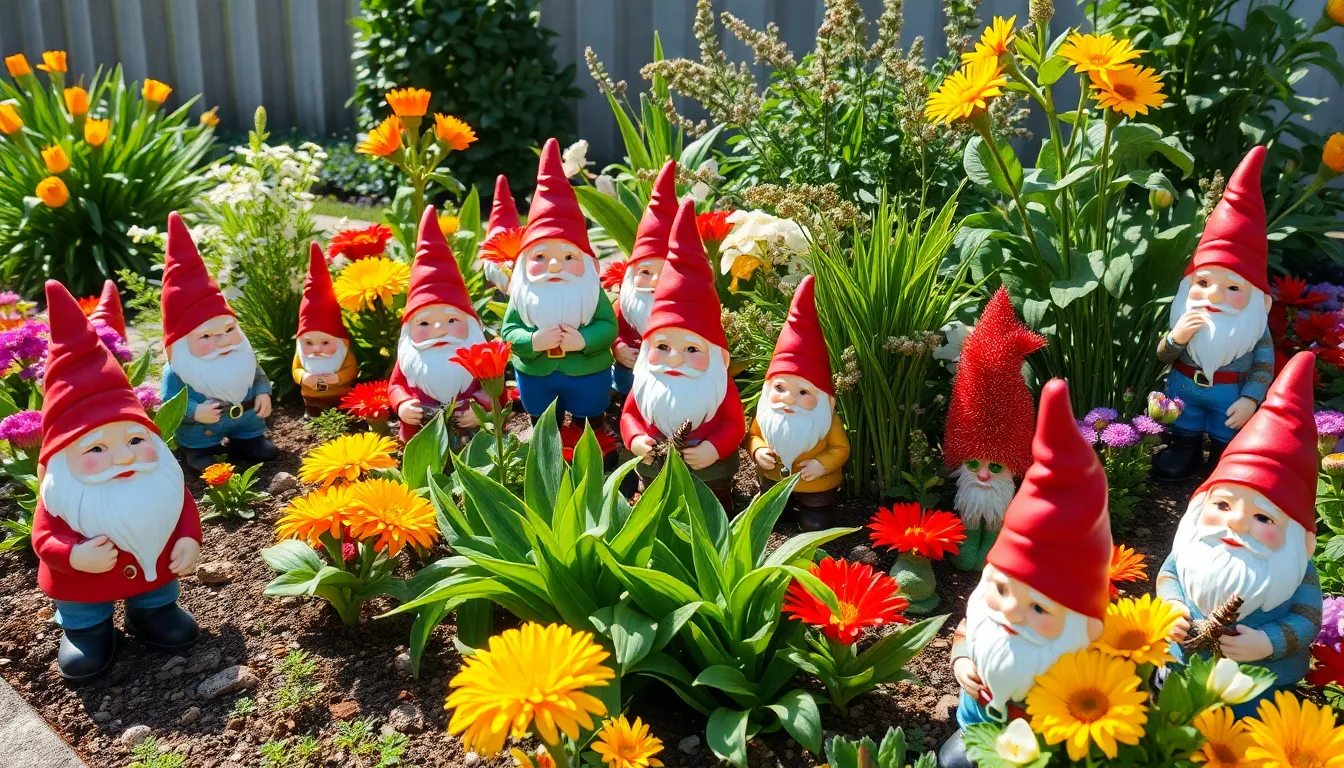
Maintaining our gnome garden throughout the seasons ensures our miniature village stays vibrant and our figurines remain in perfect condition year-round.
Spring Setup and Cleaning
Clearing winter debris marks the first essential step in preparing our gnome garden for the growing season. We should remove fallen leaves, dead plant material, and any protective coverings we used during colder months to reveal our gnome village underneath.
Inspecting each gnome figurine helps us identify any weather damage that occurred over winter. Look for chips, cracks, or fading on resin and ceramic pieces, then clean them gently with a soft brush and mild soap solution.
Preparing the soil around our miniature structures creates the foundation for healthy plant growth. We’ll need to add fresh compost or potting mix to containers and garden beds where gnomes are positioned.
Planting new additions like hostas or dwarf maples enhances our gnome garden’s beauty during spring months. Choose plants that complement the scale of our figurines while providing seasonal interest throughout the year.
Summer Care and Watering
Watering our gnome garden regularly becomes crucial during hot summer months to keep plants healthy and vibrant. We should check soil moisture daily around miniature cottages and fairy houses, especially in containers that dry out faster.
Monitoring for pests protects both our plants and gnome accessories from damage during peak growing season. Use organic methods like neem oil or companion planting to control common garden pests without harming beneficial insects.
Deadheading spent flowers on colorful companions like violas and pansies keeps our gnome village looking tidy and encourages continued blooming. This maintenance task takes just minutes but makes a important difference in overall appearance.
Adjusting gnome positions occasionally prevents sun damage and creates new storytelling opportunities throughout summer. Move figurines to shadier spots during extreme heat waves to protect painted surfaces from fading.
Winter Protection and Storage
Storing delicate gnome figurines indoors protects them from freeze-thaw cycles that can cause cracking and deterioration. We recommend wrapping each piece in bubble wrap before placing them in a dry, temperature-controlled environment.
Covering gnomes that remain outdoors requires waterproof materials specifically designed for garden protection. Use breathable fabric covers or miniature greenhouses to shield figurines while allowing air circulation.
Mulching around our gnome garden plants protects root systems from freezing temperatures and maintains soil moisture. Apply a 2-3 inch layer of organic mulch around perennials and shrubs, keeping it away from plant stems.
Documenting our gnome garden layout with photos before winter storage helps us recreate successful arrangements when spring returns. This practice saves time and ensures we maintain the storytelling elements that make our garden special.
Conclusion
Creating your dream gnome garden doesn’t have to be overwhelming or expensive. We’ve shown you how to transform any outdoor space into a magical miniature industry that tells compelling stories and brings joy throughout the seasons.
Remember that the best gnome gardens evolve over time. Start with a simple theme and gradually add elements that speak to your creativity. Whether you choose DIY habitats or budget-friendly store finds your garden will reflect your unique vision.
The key lies in balancing whimsical storytelling with practical maintenance. With proper plant pairings seasonal care and thoughtful accessorizing you’ll create an enchanting space that captivates visitors and provides endless satisfaction for years to come.
Frequently Asked Questions
What is the key to creating a successful gnome garden?
The key is designing a cohesive story rather than randomly placing gnome figurines among plants. Focus on selecting miniature residents with distinct personalities, creating pathways, and incorporating fairy-tale accessories that work together to tell an engaging narrative throughout your outdoor space.
What are the best plants to pair with gnome gardens?
Low-growing ground cover like Creeping Jenny and Dwarf Mondo Grass work best as they maintain proper scale with gnome figurines. Colorful flowers such as Violas and Pansies add cheerful blooms, while herbs like Rosemary and Chives enhance storytelling elements around culinary scenes.
How can I create a gnome garden on a budget?
Explore Dollar Tree for affordable fairy garden cottages and resin figurines. Use natural materials and recycled containers for DIY gnome habitats. Check yard sales and thrift stores for unique finds. Homemade crafting projects using everyday items can significantly reduce costs while maintaining charm.
What themes work best for gnome gardens?
Popular themes include classic fairy tale villages with red-capped gnomes, seasonal displays like Oktoberfest or winter wonderlands, occupation-based scenarios featuring gardening or cooking gnomes, and fantasy adventure stories with map-carrying gnomes and mythical creature interactions for magical storytelling.
How do I maintain my gnome garden year-round?
Spring requires clearing debris and inspecting figurines for damage. Summer needs regular watering and pest monitoring. For winter, store delicate figurines indoors and use protective coverings for outdoor pieces. Document your layout before winter to recreate successful arrangements in spring.
What accessories enhance gnome garden charm?
Miniature furniture like benches and tables create gathering spaces. Small water features add movement and tranquility. Tiny bridges and walkways connect different areas. These props enhance the overall narrative and visual appeal while making the garden more authentic and engaging.
How should I arrange gnomes in my garden?
Position gnomes in small clusters to create engaging narratives rather than scattering them randomly. Use winding cobblestone pathways to connect village elements. Consider spiral arrangements or tiered landscapes to maximize space and create visual journeys that guide visitors through your miniature world.
Can I build custom gnome homes?
Yes! Use natural rock formations for authentic dwellings, repurpose terra cotta pots and old teacups as container homes, or construct rustic cabins from wooden logs and branches. Custom homes reflect your garden’s unique story and add personalized charm to the overall design.

